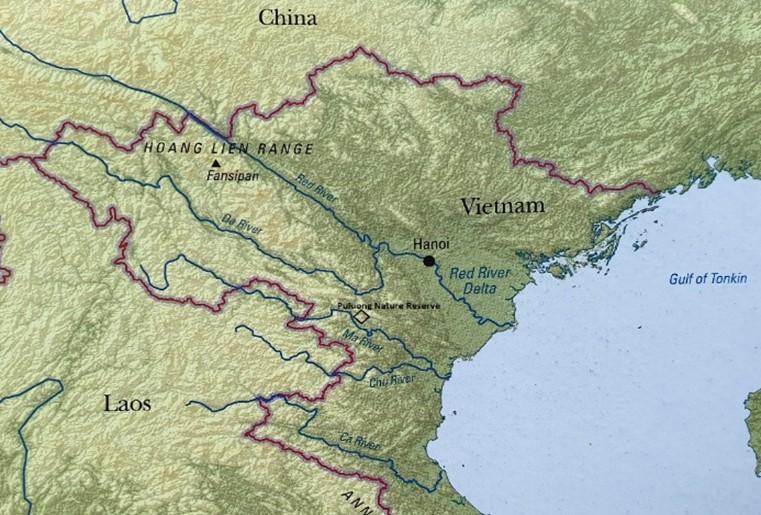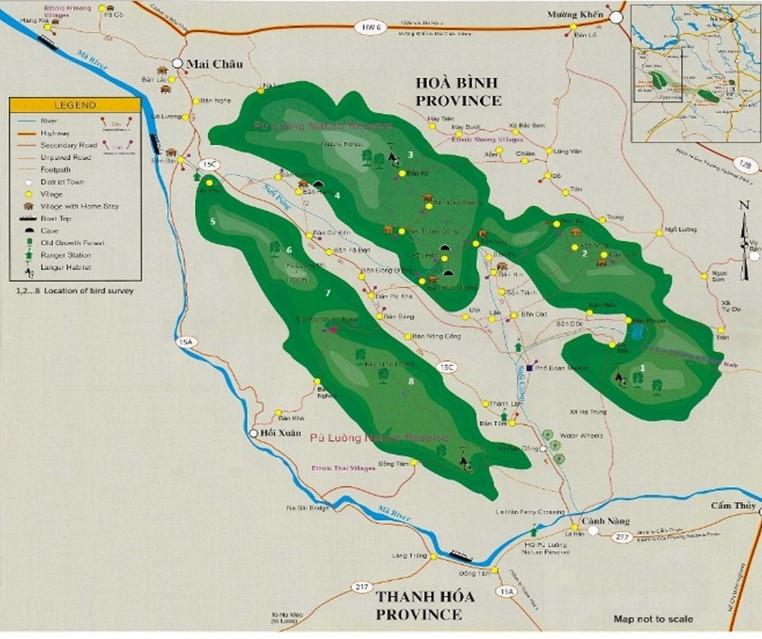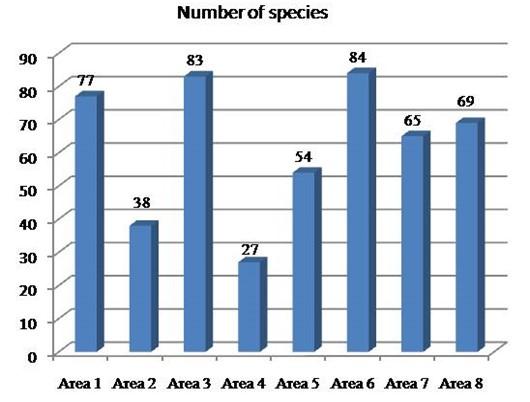Birds from Pu Luong Nature Reserve, Thanh Hoa Province, North Vietnam: an update on biodiversity and checklist
Abstract
Combining use of various methods of bird study from line transect observations, birds capture and release by mist-nets, collection of specimens from local people and analysis of samples kept at Pu Luong Nature Reserve (NR) office throughout the time from 2015 to 2018 and inherit the results of previous studies, we provide an updated list of 252 species of bird belonging to 58 families and 15 orders from Pu Luong NR, Thanh Hoa Province, North Vietnam.. A total of 216 species of birds were recorded during four years. In which, 74 species are reported for the first time from this nature reserve, and 41 species are first records for the avifauna of Thanh Hoa Province. Additional, the data of distribution characters of avifauna in each study site are also provided. According to the International Union for the Conservation of Nature (2019), five species were in the Near Threatened category and three species were in the vulnerable category. Compared to 6 other National Park (NP) and NR in the North Central Coast of Vietnam, the avifauna in Pu Luong NR is close to the avifauna in Pu Hu NR. There are 89 common bird species recorded in all 7 NP and NR, while there are 15 species recorded only in Pu Luong NR. Birds are considered as good bio-indicators of the degree of human disturbance to the forest ecosystem. Observing changes in bird community can assess the status of the forest in the future.
INTRODUCTION
Vietnam is one of the countries with the richest of avifauna in Southeast Asia. The total number of birds recorded from 828 in 1999 [1] to 887 in 2011 [2] and may be up to 943 species in 2019 [3]. Vietnam is home to 19 endemic bird species and subspecies groups, and another 27 near-endemic species, the largest number of any country in mainland South-East Asia [4]. The Government of Vietnam has planned a national special-use forests system to conserve and develop sustainably important natural ecosystems and endangered, precious and rare wildlife including 34 NP, 58 NR, 14 habitat and species conservation areas, 61 ecological landscape protection areas, nine forest scientific experiment sites [5]. The investigation of the updated list of species in protected areas has important implications in the management, protection and sustainable development of forest resources.
Pu Luong NR was established in 1999 to conserve typical ecosystems, flora and fauna species of lowland areas on Limestone Mountains. These are located in North Central Coast of Vietnam with a total area of 17,171.53 ha (according to the adjusted plan of 2013), the Pu Luong NR is divided into three functional subdivisions: strict protection subdivision (12,561.60 ha), forest rehabilitation subdivision (4,300.40 ha) and administrative and service subdivision (216.03 ha), other land (93 ha). With the beautifully and typically ecological landscape of high mountains ranging from 60 to 1,667m above sea level, the highest peak is Pu Luong Mountain, Pu Luong NR attracts many international tourists to visit and home stay. The diversity of habitat and topography has created a diversity of bird species here including resident and migratory birds. It is likely that Pu Luong has strong avifauna affinities with Cuc Phuong National Park, which is situated to 25km to the south-east, along the same limestone range. However, the higher elevations at Pu Luong NR and the presence of more extensive arears of evergreen forest means that Pu Luong NR can be expected to support a number of species that are not present at Cuc Phuong [6]. The results of bird survey of Le and Do (1998) recorded 169 bird species in Pu Luong NR [7]. The recent study of Trinh et al. (2013) in Pu Luong NR recorded 117 bird species [8]. Our research for 4 years from 2015 to 2018 has continued to update and supplement bird species for this area. New records for the region, those not recorded, species and areas of conservation priority are discussed in this study.
MATERIALS AND METHODS
Study area
Pu Luong NR is the first point of forest ecosystems on the limestone range Pu Luong – Ngoc Son, Ngo Luong – Cuc Phuong with two parallel mountain ridges that run from north-west to south-east, and are bisected by a central valley. This valley contains several human settlements and a large area of agricultural land and hence, is not included within the nature reserve area. The coordinates of Pu Luong NR: 20021′- 20034’N, 105002′- 105020’E. The two mountain ridges in the NR have starkly contrasting landforms, based on their different substrates. The smaller, south-western ridge is made up of mostly igneous and metamorphic rocks, and consists of rounded forested hills and wide, shallow valleys. The larger, north-eastern ridge is composed of heavily dissected limestone karsts, and is a continuation of the limestone range that runs from Cuc Phuong National Park to Son La province [6].
The primary forest at Pu Luong NR is classified as closed evergreen tropical seasonal forest. Five major subtypes occur as a result of local variations in underlying substrate and elevation: lowland broadleaved forest on limestone (60 to 700m); lowland broadleaved forest on schist/shale and clayey sandstone (60 to 1,000m); broadleaved submontane forest on limestone (700 to 850m); and broadleaved submontane forest on basalt (1,000 to 1,650m). The NR also supports a range of secondary vegetation types, including secondary forests, bamboo, scrub and agricultural land [9].
Bird survey was conducted in eight areas along the two mountain ridges of Pu Luong NR. Characteristics of the study areas are described briefly in Table 1.

Table 1. Brief description of habitat at each study area has been visited between 2014 and 2018 in Pu Luong Nature Reserve.
Study methods
Frequent site visits, observations and discussions with local people were used to determine bird species in Pu Luong NR. A variety of Vietnam and regional guide book was used in the present study to identify bird species [10, 11, 12] We used mist nettings as a tool to support determining what species are present in a study area. The technique is a valuable component of species inventory because it detects more cryptic, ground-foraging, and non-singing birds than aural or visual surveys [13, 14]. The identification process for avian species was performed at the site or at the Museum of Biology, Hanoi National University of Education (HNUE) for captured and dead species. Taxonomy and nomenclature primarily follow Robson (2015) [12], but we have adopted more recent updates that clearly provide a more thorough perspective on nomenclature and species relationships (Birdlife International, HBW, 2016) [15]. Species conservation status follows the Red List of Threatened Species (IUCN, 2019) at the global level [16].

RESULTS
Bird species recorded from Pu Luong Nature Reserve
In total, 216 bird species belonging to 135 genera, 55 families, 14 orders were recorded in Pu Luong NR over 4 years survey period (2015-2018), including 114 species were taken by photo, 43 species by observation, 31 species were captured – release by mist netting, 28 species specimens (collected from local communities and management board of Pu Luong NR). Our research results updated the birds list in Pu Luong NR to 252 bird species belonging to 58 families and 15 orders (Table 2).
In order to relatively assess the animal geographic relationship between Pu Luong NR and other NR and NP in the North Central Coast, we made a comparison of bird species diversity between Pu Luong NR with Pu Hu NR [16], Xuan Lien NR [17], Ben En NP [18], Cuc Phuong NR [19], Pu Mat NP [20], Pu Huong NR [21]. Results of analysis and comparison are shown in Table 3. The total number of bird species recorded in 7 NP and NR in these areas is 485 species. Among them there are 89 common bird species recorded with all 7 NP and NR.
Status residential and distribution
Among of 252bird species were recorded in this study and previous study in Pu Luong NR, there are 109 species of resident birds, 38 species of winter visitor, onespecies summer visitor, threespecies of passage migrant and onespecies unknown.
Table 2. Bird species recorded in Pu Luong Nature Reserve, Thanh Hoa Province, Vietnam, 2015-2018.
Table 3. Comparing the diversity of bird species composition of Pu Luong NR and other NP and NR in the North Central Coast of Vietnam.
DISCUSSION
A summary of bird species recorded in eight different study areas in Pu Luong NR shows that the diversity of bird species composition is markedly different. Area 6 on the land mountain range and Area3 on the limestone mountain range have the most bird species diversity. This is followed by Area 7. The Areas 4 and Area 2 on the limestone moutain range have the least recorded number of bird species (only from 27 to 38 bird species were recorded) (Figure 3).
The result has identified ninebird species are important for conservation priority in Pu Luong Nature Reserve base Red list of the International Union for the Conservation of Nature (2019) [16]. Of these, fivespecies listed as Near Threatened and threespecies listed asVulnerable. In particular, two species Aceros undulatus and Sitta solangiae have just been listed in the IUCN Red List since 2018. Therefore, it can be seen that in recent years the forest has been being exploited, the situation of people trapping and hunting birds is still happening. This causes the number of species to be significantly reduced compared to before.
When comparing Pu Luong NR with 6 other NP and NR in the North Central Coast of Vietnam, it shows that Pu Luong NR has area not to large. Pu Luong NR has the highest bird species composition similarity to Pu Hu NR (Table 3). This is explained by Pu Luong NR and Pu Hu NR also located in the Northwest of Thanh Hoa Province, which are two adjacent areas with similar terrain, climate, fauna and area. There are 15 bird species recorded only in Pu Luong NR. The location at the beginning of Pu Luong – Ngoc Son, Ngo Luong – Cuc Phuong limestones mountain range has also created a unique feature for the avifauna of Pu Luong NR.
The results of our study have added 74 new species to Pu Luong NR compared with previous studiesby Le& Do (1998) [7] and Trinh et al. (2013) [8]; 41 species are new records for Thanh Hoa Province. Also, 30 species arerecorded for the North Central Coastof Vietnam according to “Checklist of the birds of Vietnam” by Vo andNguyen (1999) [1] and Nguyen and Nguyen (2011) [2] (Table 1).
During the study, 40 bird species not recorded compare with the previous studies by Le and Do (1998) and Trinh et al. (2013). It is noteworthy that two large-sized birds of the horn family (Great Hornbills and Tickell’s Brown Hornbill) were previously inhabited there, which have been recorded in the past, but during the fieldwork we have not seen again. The cause may be that these species have been over-hunted, resulting in reduced numbers of bird populations. On the other hand, the living environment of these birds is the primary forest with large timber trees, which has been over-exploited, so the remaining area is very small (less than 5% of total natural forest area) and is spread in the sheer mountains that difficult to access. So, the field investigation process is very hard to detect a few of these remaining birds.
Pu Luong NR is located at the beginning of the limestone range of Pu Luong – Ngoc Son, Ngo Luong – Cuc Phuong with the highest peak in Pu Luong (1,700m) with thelargest lowland limestone mountains forest system remaining in Northern Vietnam. Pu Luong has both tropical vegetation types and subtropical vegetation. The diversity of habitats and food sources has created a diversity of bird species. Therefore, this study has further updated 74 species of birds for the NR. The avifauna in the northeastern limestone range of the NR is characterized by a distinctive bird species. Research in four areas on this mountain range has recorded 151 birds species belonging to 46 families. The group of birds that eat insects most diverse with 131 species, the group of birds that eat plants (soft fruits, seeds, sprout) has 58 species and 23 species of raptors. The dominant species in limestone mountain ecosystems are mainly species in the family Timaliidae (13 species), Muscicapidae (12 species), Pycnonotidae (10 species). The families Picidae, Accipitridae, Nectariniidae all have 8 species. The dominant species of limestone mountain ecosystems still belong to the birds that eat insects.
Many bird species of large size have been easy recognized previously in Pu Luong but are no longer recorded in this study such as Polyplectron bicalcaratum, Buceros bicornis, Anorrhinus tickelli, Harpactes erythrocephalus, Cissa hypoleuca, Corvus macrorhynchus. These are the biological indicators that reflect the status quality of the forest. If the negative impacts such as illegal hunting of forest animals, illegal logging, forest land are encroached, narrowed to economic development, free grazing of cattle, making roads etc, the biodiversity will continue to decline. This will directly affect the sustainable development of the locality, especially Thanh Hoa Province, which is frequently affected by natural disasters and floods in the context of global climate change.

ACKNOWLEDGEMENT
We are grateful to the directorates of the Forest Protection Department of Thanh Hoa Province and Pu Luong Nature Reserve for support of our fieldwork and issuing relevant permits. We thank Ly Ngoc Tu, Vu Thi Tham from HNUE for their assistance in the field. We thank Richard Craik and Le Quy Minh for providing the map. This research was supported by the Ministry of Education and Training (Project B2017-SPH-26) for Nguyen Lan Hung Son. We are grateful to the referee for all the comments and editing of MSS.
AUTHORS CONTRIBUTIONS
Hung Ngoc Hoang, Son Hung Lan Nguyen and Cu Nguyen were involved in design of the experiments. Hung Ngoc Hoang, Son Hung Lan Nguyen contributed to perform the experiments, analyzed the data and prepared a draft of manuscript. Cu Nguyen supervised the research work. The final manuscript was carefully revised and approved by all authors.
CONFLICTS OF INTEREST
The authors declare no conflict of interest.
References
- [1]Vo Q, Nguyen C. Checklist of the Birds of Vietnamese, second printed. CRES-VNU, Agricultural Publishing House, Hanoi,
- [2]Nguyen SLH, Nguyen VT. Complete Checklist of the birds of Vietnam. Agricultural Publishing House, 2011.
- [3]Birds Checklist of Vietnam, Bird Studies Canada, Birdlife International, 2019. Downloaded on March 4, 2019 from avibase.bsc-eoc.org.
- [4]Craik R, Le MQ. Birds of Vietnam. Lynx and Birdlife International Field Guides,
- [5]The Government of the Socialist Republic of Vietnam. Decision No. 1976 QD-TTg dated October 30, 2014. Approving the Planning of the national special use forest system until 2020, with a vision to 2030, 2014.
- [6]Tordoff AW, Tran BQ, Nguyen TD, Le HM (eds.) (2004): Sourcebook of existing and proposed protected areas in Vietnam. Birdlife International in Indochina and Ministry of Agriculture and Rural Development, second edition, Hanoi. CD.
- [7]Le T T and Do T. Animal resources of Pu Luong Nature Reserve. Unpublished report to the Forest Inventory and Planning Institute, Hanoi,
- [8]Trinh HV. Wild animal species composition, proposed solutions for conservation and development of wild animal species in Pu Luong Nature Reserve, Thanh Hoa province. Institute of Ecology and Works Protection, Hanoi University of Sciences- VNU,
- [9]Averyanov, LV, Nguyen HT, Phan LK, Do DT and Regalado, JC. Preliminary botanical survey of primary vegetation at Pu Luong Nature Reserve, Thanh Hoa province. Report to the Pu Luong-Cuc Phuong Conservation Limestone Landscape Conservation Project, 2003.
- [10]Nguyen C, Le T T and Karen P. Birds of Vietnamese. Publisher Labour and Society, Ha Noi, 2005.
- [11]Le HM. Birds of Vietnam. Natural Sciences and Technology Publishing House,
- [12]Robson C. Birds of Southeast Asia, second edition. Christopher Helm, Bloomsbury Publishing, London,
- [13]Keyes BE and Grue CE. Capturing birds with mist nets: a review. North American Bird Bander. 1982; 7(1): 2-14.
- [14]Bibby CJ, Jones M, Marsden S. Bird Surveys (Expedition Field Techniques Series). Bird Life International, Cambridge, 2000.BirdLife International and Handbook of the Birds of the World. Bird Species Distribution Maps of the World. Version 6.0, 2016.
- [15]The IUCN Red list of threatened species, version 2019-2, IUCN, 2019, sources: www.iucnredlist.org.
- [16]Pu Hu Nature Reserve Management Board. Final Report of Investigation Project of Checklist of fauna and flora of Pu Hu Nature Reserve, Thanh Hoa province, 2013.
- [17]Ngo TX, Le TD. Composition of birds in Xuan Lien Nature Reserve, Thanh Hoa province. Proceeding of the 6th National Scientific Conference on Ecology and Biological Resources. Agricultural Publishing House, Hanoi, 2015; pp993-999.
- [18]Ben En National Park Management Board. Final Report of Investigation Project of Checklist fauna and flora of Ben En National Park, Thanh Hoa province, 2014.
- [19]Cu N. Bird list of Cuc Phuong National Park (typed version), 2012.
- [20]Ngo TX. Study on the diversity and some ecological relationships of avifauna in Pu Mat National Park, Nghe and province. PhD thesis in Biology. Institute of Ecology and Biological Resources, 2012.
- [21]Hoang TN. Study on avifauna of Pu Huong Nature Reserve and proposing some management and protection measures. PhD thesis on Biology. Institute of Ecology and Biological Resources, 2011.